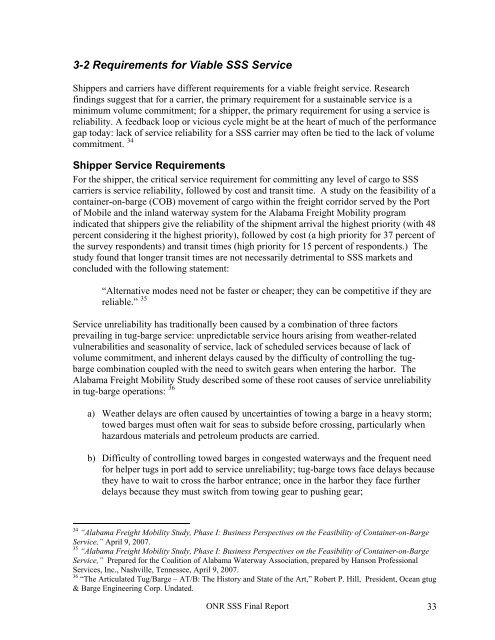Office of Naval Research - National Transportation Library
Office of Naval Research - National Transportation Library
Office of Naval Research - National Transportation Library
Create successful ePaper yourself
Turn your PDF publications into a flip-book with our unique Google optimized e-Paper software.
3-2 Requirements for Viable SSS ServiceShippers and carriers have different requirements for a viable freight service. <strong>Research</strong>findings suggest that for a carrier, the primary requirement for a sustainable service is aminimum volume commitment; for a shipper, the primary requirement for using a service isreliability. A feedback loop or vicious cycle might be at the heart <strong>of</strong> much <strong>of</strong> the performancegap today: lack <strong>of</strong> service reliability for a SSS carrier may <strong>of</strong>ten be tied to the lack <strong>of</strong> volumecommitment. 34Shipper Service RequirementsFor the shipper, the critical service requirement for committing any level <strong>of</strong> cargo to SSScarriers is service reliability, followed by cost and transit time. A study on the feasibility <strong>of</strong> acontainer-on-barge (COB) movement <strong>of</strong> cargo within the freight corridor served by the Port<strong>of</strong> Mobile and the inland waterway system for the Alabama Freight Mobility programindicated that shippers give the reliability <strong>of</strong> the shipment arrival the highest priority (with 48percent considering it the highest priority), followed by cost (a high priority for 37 percent <strong>of</strong>the survey respondents) and transit times (high priority for 15 percent <strong>of</strong> respondents.) Thestudy found that longer transit times are not necessarily detrimental to SSS markets andconcluded with the following statement:“Alternative modes need not be faster or cheaper; they can be competitive if they arereliable.” 35Service unreliability has traditionally been caused by a combination <strong>of</strong> three factorsprevailing in tug-barge service: unpredictable service hours arising from weather-relatedvulnerabilities and seasonality <strong>of</strong> service, lack <strong>of</strong> scheduled services because <strong>of</strong> lack <strong>of</strong>volume commitment, and inherent delays caused by the difficulty <strong>of</strong> controlling the tugbargecombination coupled with the need to switch gears when entering the harbor. TheAlabama Freight Mobility Study described some <strong>of</strong> these root causes <strong>of</strong> service unreliabilityin tug-barge operations: 36a) Weather delays are <strong>of</strong>ten caused by uncertainties <strong>of</strong> towing a barge in a heavy storm;towed barges must <strong>of</strong>ten wait for seas to subside before crossing, particularly whenhazardous materials and petroleum products are carried.b) Difficulty <strong>of</strong> controlling towed barges in congested waterways and the frequent needfor helper tugs in port add to service unreliability; tug-barge tows face delays becausethey have to wait to cross the harbor entrance; once in the harbor they face furtherdelays because they must switch from towing gear to pushing gear;34 “Alabama Freight Mobility Study, Phase I: Business Perspectives on the Feasibility <strong>of</strong> Container-on-BargeService,” April 9, 2007.35 “Alabama Freight Mobility Study, Phase I: Business Perspectives on the Feasibility <strong>of</strong> Container-on-BargeService,” Prepared for the Coalition <strong>of</strong> Alabama Waterway Association, prepared by Hanson Pr<strong>of</strong>essionalServices, Inc., Nashville, Tennessee, April 9, 2007.36 “The Articulated Tug/Barge – AT/B: The History and State <strong>of</strong> the Art,” Robert P. Hill, President, Ocean gtug& Barge Engineering Corp. Undated.ONR SSS Final Report 33
















